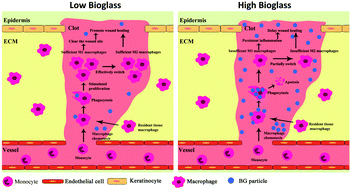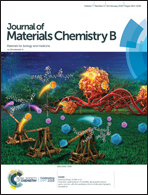Dose-dependent modulation effects of bioactive glass particles on macrophages and diabetic wound healing†
Abstract
Many pathophysiologic conditions can interrupt the normal wound healing process and lead to chronic wounds due to the arrest of macrophages in their inflammatory phenotype. Thus, strategies that promote the recovery of macrophage functions are of great benefit to heal chronic wounds. Bioactive glass (BG) dissolution has been recognized for its modulatory functions in macrophage polarization. However, further efforts are greatly needed to address how BG particles affect macrophage behaviors (such as proliferation, viability, migration and polarization) and wound healing through both direct contact and released ions. Our results showed that BG particles affect the proliferation/viability and polarization of macrophages in a dose-dependent manner. At a low concentration (20 μg mL−1), BG particles stimulated macrophage proliferation and promoted the M1-to-M2 phenotype switch; meanwhile, at a high concentration (100 μg mL−1), the particles showed significant cytotoxicity and prolonged the M1 phenotype of macrophages. The BG particles also exhibited strong chemotaxis to macrophages which appeared to be independent of their concentration. Dose-dependent regulation of macrophages and wound closure by BG particles were also observed in the healing of full-thickness wounds of diabetic rats. Our study suggests that the BG particle-mediated activities of macrophages are essential to wound healing, and these activities are greatly correlated with the amount of BG particles.



 Please wait while we load your content...
Please wait while we load your content...